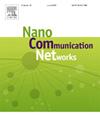Parity generator-checker based nano communication network using reversible quantum majority voter
IF 4.7
4区 计算机科学
Q2 ENGINEERING, ELECTRICAL & ELECTRONIC
引用次数: 0
Abstract
Quantum computing has emerged as a transformative paradigm with profound implications for computation, communication, encryption, and information theory. As classical systems approach their miniaturization and energy-efficiency limits, quantum technologies offer new mechanisms rooted in superposition, entanglement, and reversibility. This paper introduces a foundational nanocommunication framework that integrates three known reversible circuit primitives—majority voter, parity generator, and parity checker—into a unified communication system. Unlike prior works that analyze these circuits in isolation, the proposed architecture validates their combined functionality on the IBM Quantum platform, tested under both ideal (Aer simulator) and realistic noisy (NISQ hardware) conditions. By incorporating depolarizing noise models, mid-circuit resets, and hardware execution, the framework directly reflects the physical constraints of real devices, including qubit errors, decoherence, and relaxation effects. Simulation and hardware results demonstrate system-level fidelity, circuit cost, and accuracy for both small- and higher-bit counts. Comparative analysis with existing teleportation- and entanglement-based protocols highlights the efficiency and scalability of the approach. Overall, this study establishes a practical and foundational step toward noise-resilient, parity-based quantum communication systems, paving the way for larger processor-scale designs in the future.
基于奇偶生成器校验器的可逆量子多数投票人纳米通信网络
量子计算已经成为一种革命性的范式,对计算、通信、加密和信息理论有着深远的影响。当经典系统接近其小型化和能效极限时,量子技术提供了基于叠加、纠缠和可逆性的新机制。本文介绍了一个基本的纳米通信框架,该框架集成了三种已知的可逆电路原语-多数投票人,奇偶校验器和奇偶校验器-到一个统一的通信系统中。与之前孤立分析这些电路的工作不同,所提出的架构在IBM量子平台上验证了它们的综合功能,并在理想(Aer模拟器)和现实噪声(NISQ硬件)条件下进行了测试。通过结合去极化噪声模型、中路复位和硬件执行,该框架直接反映了实际设备的物理约束,包括量子位误差、退相干和松弛效应。仿真和硬件结果证明了系统级保真度、电路成本和小比特数和高比特数的精度。与现有的基于隐形传态和纠缠的协议的比较分析突出了该方法的效率和可扩展性。总的来说,这项研究为抗噪声、基于奇偶的量子通信系统迈出了实用和基础的一步,为未来更大的处理器规模设计铺平了道路。
本文章由计算机程序翻译,如有差异,请以英文原文为准。
求助全文
约1分钟内获得全文
求助全文
来源期刊

Nano Communication Networks
Mathematics-Applied Mathematics
CiteScore
6.00
自引率
6.90%
发文量
14
期刊介绍:
The Nano Communication Networks Journal is an international, archival and multi-disciplinary journal providing a publication vehicle for complete coverage of all topics of interest to those involved in all aspects of nanoscale communication and networking. Theoretical research contributions presenting new techniques, concepts or analyses; applied contributions reporting on experiences and experiments; and tutorial and survey manuscripts are published.
Nano Communication Networks is a part of the COMNET (Computer Networks) family of journals within Elsevier. The family of journals covers all aspects of networking except nanonetworking, which is the scope of this journal.
 求助内容:
求助内容: 应助结果提醒方式:
应助结果提醒方式:


